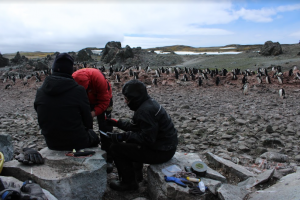Punta Arenas, April 3, 2023.- Chinstrap penguins, during their reproductive period, feed almost exclusively on krill. But, what will happen to them if the availability of their main food is affected by environmental conditions such as rising temperatures, reduced sea ice and lower marine productivity? Will it negatively impact their populations, their reproduction and, consequently, in their young?
Some answers are contained in a recent study published in Scientific Reports, one of the most important science magazines on the planet, in which researchers from the Scientific Department of the Chilean Antarctic Institute (INACH), Francisco Santa Cruz, Lucas Krüger and César Cárdenas participated, these last two are also members of the Millennium Institute for Biodiversity of Antarctic and Sub-Antarctic Ecosystems (BASE).

The importance of this article lies in being one of the few works that directly relates food availability, feeding behaviors of a marine predator (chinstrap penguin) and evaluation of environmental parameters. “There are almost no studies linking in a synchronized manner the satellite tracking of marine predators, the acoustic abundance of krill, and satellite environmental information. Even more important is having achieved it during several consecutive campaigns; this allowed us to generate a time series with which we were able to answer key questions. Chile is one of the first countries to achieve this in Antarctica”, says Francisco Santa Cruz, one of the authors of the letter.
In simple words, everything is connected: the amount of sea ice influences the oceanic primary productivity when it melts in spring-summer and, consequently, there is less availability of krill that chinstrap penguins feed on. “The penguins in the study area have adapted in such a way that they synchronize the birth of their chicks with these increases in productivity that are more or less cyclical and predictable. When environmental variations cause oceanic productivity peaks to change in space or time, penguins are probably not able to maintain the same chick survival rates. This is what our results indicated for the colony we have studied”, explains Dr. Lucas Krüger, a specialist in Antarctic birds.
To reach these conclusions, different sampling techniques were combined, such as transects in the INACH Karpuj scientific boat, penguin tracking with GPS devices and TDR depth sensors, as well as aerial photographs taken with a drone. “Thanks to scientific platforms such as Karpuj, we have been able to collect important acoustic data on krill, in order to be able, together with satellite data, to help understand bird feeding patterns and how these are influenced by the environment in the face of changes in krill availability. ”, expressed Dr. César Cárdenas.
The work focused specifically on Punta Armonía, Nelson Island (South Shetland Islands) in the INACH Antarctic Scientific Expeditions of the years 2019-2020 (ECA 56) and 2021-2022 (ECA 58). On the island there is a Specially Protected Antarctic Zone (ASPA), where the environment is protected from human presence in activities such as tourism and intensive research. “In this case, we only focused on Nelson Island, because it is the site where we have been monitoring since 2019, we also took acoustic data to estimate the abundance off the island, which helped to carry out a more complete study that did not it only includes the satellite tracking of the birds”, mentions Cárdenas.
Preliminary results indicate that this population has been reduced by more than half, following the reduction values that were presented in another study, but it remains an important colony of chinstrap penguins in the South Shetland Islands.
In this sense, the study that has just been published is connected to other previous research published by Krüger at the beginning of March, where it is suggested that the increase in the frequency of years of low krill availability due to the increase in winter temperatures , could eventually explain the population trends that are verified in the northernmost areas of the Antarctic peninsula. However, it will be necessary to verify if this phenomenon is repeated in more colonies for this hypothesis to be accepted.
The importance of Marine Protected Areas
For Dr. César Cárdenas, this study is a new piece to the puzzle of the work carried out in the INACH Marine Protected Areas Program and also the annual monitoring that has been carried out at Punta Armonía since 2019. This type of study highlights the importance of protecting The antartica. “The environment is changing, so it is necessary to improve our knowledge of how organisms behave and how they are affected by environmental changes, which will increase in the future according to climate change projections,” he points out.
These INACH researchers are working on a proposal for a Marine Protected Area (AMP) for Domain 1 (Antarctic Peninsula), a tool for ocean conservation and to safeguard biodiversity and manage fisheries, while restoring and preserving the ecosystem function, which is strongly challenged by climate change.

The MPA for Domain 1 is critical to prevent another driver of krill decline, such as fisheries, from having an additional impact, eventually reducing the ability of chinstrap penguins to adapt to changes in their environment. For example, in periods of low krill availability, fisheries could prevent them from being caught and still available to penguins.
Nuria Salmerón and Solenne Belle also participated in the scientific article “Environmental changes generate less availability of Antarctic krill, affecting the reproduction of chinstrap penguins in the Antarctic Peninsula”, who completed their master’s thesis in 2022 at INACH by the International Master of Science in Marine Biological Resources (IMBRSea), from the University of Ghent, Belgium. As authors, the contribution of Nicolás Alegría from the Fisheries Research Institute (Inpesca), Júlia Gronmann Finger, Denyelle Hennayra Cora and María Virginia Petry from the Ornithology and Marine Animals Laboratory of the University of Vale do Rio dos Sinos (UNISINOS) and Cristina Hernandez from the University of Magallanes.
By: Chilean Antarctic Institute (INACH)
Main image: Francisco Santa Cruz
